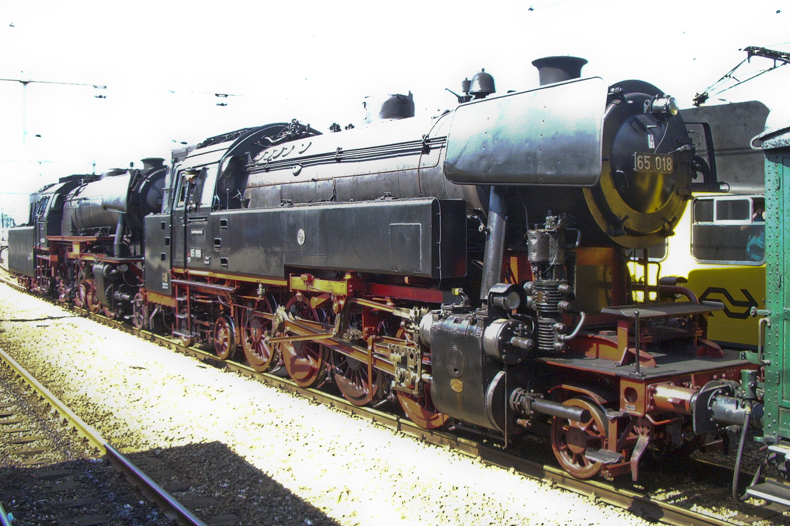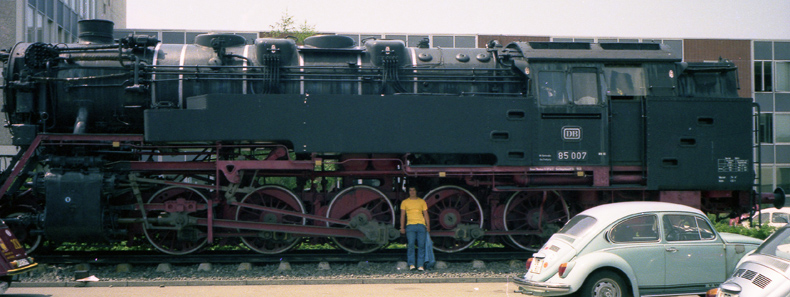Garrattfan's Modelrailroading Pages

Collection
DB Baureihe 65 015
The prototype
Neubaulokomotiven (New Build locomotives) in general
Shortly after WWII the West-German Railways (DB) started planning a whole new generation of steam locomotives, mainly to displace the older steam locomotive designs from before the 1923 unification program. This new generation featured modern developments as cast frames, roller bearings, welded high performance boilers and electric lighting and welded construction. Friedrich Witte was responsible for their development. Many classes were planned, fewer ordered and in fact very few actually built as the change of traction cut all plans short in the mid fifties.
| Dimension | 10 | 23 | 65 | 66 | 82 |
|---|---|---|---|---|---|
| Wheel arrangement | 2'C1' 4-6-2 |
1'C1' 2-6-2 |
1'D2'T 2-8-4T |
1'C2'T 2-6-4T |
ET 0-10-0T |
| Length (mm) | 26,503 | 21,325 | 15,475 | 14,798 | 14,060 |
| Speed (km/h) | 140 | 110 | 85 | 100 | 70 |
| Power output (kW) | 1,839 | 1,313 | 1,089 | 861 | 949 |
| Tractive effort (kgf) | 15,676 | 12,778 | 14,010 | 10,206 | 16,632 |
| Driver diameter (mm) | 2,000 | 1,750 | 1,500 | 1,600 | 1,400 |
| Weight in service (ton) | 208 | 145 | 108 | 94 | 92 |
| Adhesive weight | 66 | 56 | 68 | 47 | 92 |
| First delivery | 1956 | 1950 | 1951 | 1955 | 1950 |
| Last delivery | 1956 | 1959 | 1956 | 1955 | 1955 |
| First withdrawn | 1967 | 1966 | 1967 | 1966 | |
| Last withdrawn | 1968 | 1976 | 1972 | 1968 | 1972 |
| # planned | |||||
| # ordered | |||||
| # actually built | 2 | 105 | 18 | 2 | 41 |
| # surviving | 1 | 8 |
1 | 1 | 1 |
All in all the plans for and the lives of the new classes were short lived. Sometime no more than 11 years of service rested on these engine when they where scrapped. Nevertheless these classes were very successful. They were genereally pleasing to te eye, sleek modern designs. And technically they rank among the best steam locomotives ever built in Germany incorporating many of the lessons that had been learned in the last decade. Their early demise was simply a sign of the time.
20 June 2005. A 23 and a 65 class leading a steam by StoomStichting Nederland in Utrecht Central station.
All photos ©2019 René F. Vink / Garrattfan. Apologies for the quality of these images, but it was in the very early days of digital photography and my Pentax Optio S50 was a bad performer under this harsh sunlight.
The 23 class was in many respects designed along the same lines.
Well, here it is, the only survivor of the 65 class. Clearly visible are its welded features and elegant, well-propotioned design.

The 65 class
The steam locomotives of DB Class 65 were were intended for suburban and commuter trains serving German cities, where they were to replace Classes 78 and 93.5. As a result, they were allocated to the locomotive depots (Bahnbetriebswerke or BW) at Darmstadt, Düsseldorf and Letmathe. Between Düsseldorf and Essen they were even used on early S-Bahn services. And between Limburg/Lahn and Wiesbaden and in the area of Darmstadt they also hauled goods trains. The firm of Krauss-Maffei initially delivered 13 engines in 1951 and a further 5 from 1955 to 1956. The first engine, with operating number 65 001, was retired as early as 1966. All the vehicles were given a welded, high-performance boiler. Operating numbers 65 001 - 65 013 were equipped with a surface economizer. Numbers 65 014 - 65 018 were given a mixer preheater. Numbers 65 012 - 65 018 were equipped for push-pull services. So there were three different variants of these two-cylinder, superheated steam engines in service with the Bundesbahn.
Class 65 locomotives proved to be exceptionally reliable engines, but they could not be used universally, because their coal bunkers and water tanks were small. As a result, they could only be used for short-range goods traffic. Locomotive 65 018 was given a special lightweight drive, which was later used on all the engines. This locomotive is the only representative of its class to have survived in working order and is owned by the Stoom Stichting Nederland society in the Netherlands, having been donated by a German railway museum in 1981. It currently resides at the VSM on loan and is currently being overhauled.
(WikiPedia)
The model
A model of the 65 was etched in my memory in my younger years. My close friend Hans was very much into Fleischmann and had this beautiful BR 65 model running on his modest layout. We spend a lot of time together modelling and train spotting. Many of my youth photos came into existence during our mutual train spotting days.

A photo dating back to 1976. Hans hugging the plinthed the pre-war 85 007, Technische Fachhochschule Konstanz, Germany.
I always loved the model for its beautiful design and I carried a happy reminiscence of that model and that happy friendship ever since. The contact may have loosened at times but the friendship never went away and now spans over 45 years. One day in 2018 we returned from a visit to a mutual friend and I made a remark about my happy memories of the BR 65. He immediately responded that he had two models and to mark our lifelong friendship he wanted to give me one of them. This gesture moved me to the bone. So on 15 February 2019 on another visit he handed it over.
Since then it sits proudly and fondly looked after in my display cabinet.
43 years have passed since the previous photo.. |
|


Sign my
GuestBook